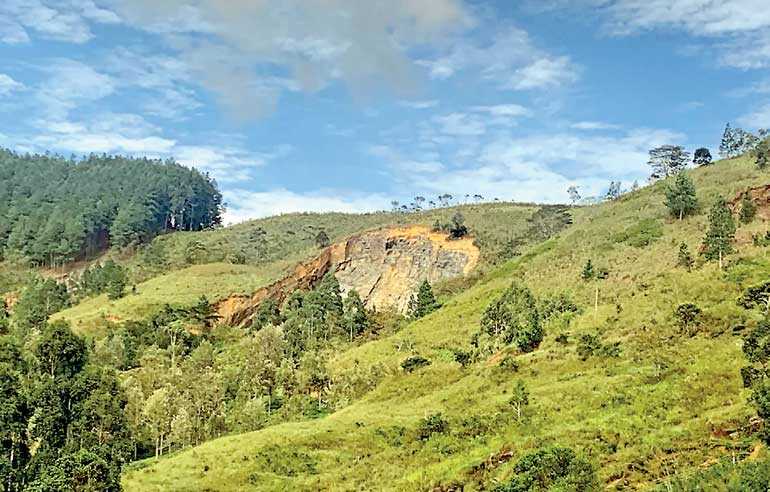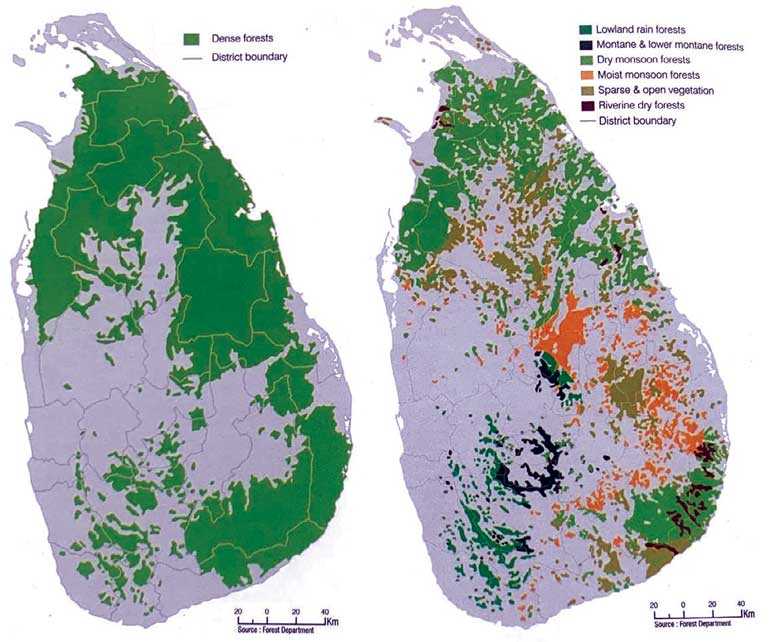Thursday Apr 03, 2025
Thursday Apr 03, 2025
Tuesday, 29 December 2020 00:54 - - {{hitsCtrl.values.hits}}

Mining of sacred mountain tops is now a commercially approved enterprise (Ella 2020)
By Ravi Bandaranaike
In 300 BC, Mahinda Thera, bringer of Buddhism to Lanka and son of the Great Emperor Ashoka, said to king Devanampiyatissa of Sri Lanka: “Remember that you are only the guardian of this land for all the people and animals that reside here, not the owner of it.”
Sitting in my grandparents’ old house, I contemplate the days when one could see the sea from the back window. Now the land is worth Rs. 15 million a perch. The 90-year-old art nouveau house has been split in two. The three-story tall frangipani in my garden is one of the last magnificent trees left in this block. The scent of the falling Araliya flowers daily permeates through the air; a sensory symbol that reality is, in fact, not STATIC like concrete.
A hardware company just tore down the landmark Cricket Club Cafe to build a car park and the iconic Gallery Cafe shop to build another apartment building. The land value in our neighbourhood has now dropped by 25%. I had to make a personal call to the owner of one of the biggest construction companies just to save the last trees next to the apartment building.
The contractor told me it was not his responsibility as he piled sand and cement onto the tree’s roots. Why don’t these corporate businessmen hire some gardeners to help them think straight? Any backing theory economist could tell you that the value of land is mostly tied directly to the hundred plus year old trees inhabiting it.
It is 2020 and COVID-19 is rampant in the world; the average Sri Lankan is still struggling to make it through the month; who is going to live in these high rise towers anyways? I remember the last time I saw the candy floss (bombai-motai) man who has been walking these streets for 30 years. He was standing under a tree (now gone) taking cover from the rain, and he looked at me from the distance and gently rang his bell. It was a tinkle of sadness. And, just like that, I never saw him again.
The city and the people’s wants had changed, and only he and I seemed to notice. I recall when an apartment building came up a few years ago next to the British Council because the humongous tree next to Queens cafe died right after.
How did the vast blue ocean that lay before us become synonymous with dull grey concrete? Something in the construction dust from these 1980’s-inspired monolithic buildings poisons the air we all breathe from. Or could it be the smog from all the petrol cars we’ve been importing?
Most people living in Colombo don’t even understand where their food, water and oxygen come from. For all they know it is grown in plastic bags at the back of their local Food City. Out of sight = out of mind. Our people are still not conscious that Sri Lanka is one of the last remaining places left on earth where humans still live with animals.
Where organic food has been a thing for 2,500 years. Where recycling is part of village culture. Where giant lakes were built by noble kings as a hobby. Where sacred peaks were once worshipped, not one year old apartment buildings demarcating the destruction of an entire neighbourhood of beautiful gardens.
Let’s just say it’s already too late for Colombo, once one of the greenest cities in the world, now completely ruined by gross governmental mismanagement. Right now the remaining forest lands in Sinharaja, Knuckles and Haputale are quietly being encroached upon by local villagers aided by local politicians for a few Rs. 100,000.
Corporations continue palm oil cultivation and heavy duty quarrying in secrecy. The lungs of this island are becoming clogged by the tar of toxic human dreams. The damage to our commons and future tourism industry will be in the billions of dollars. Scenic mountain towns like Ella have been ruined in just three years by unregulated construction and disastrous waste management.
What is the Tourism Board doing about the destruction unfolding as they continue to market a beautiful place that no longer exists? I have long wished that the President of Sri Lanka gets the STF and Navy to protect our LRC forest lands and coral reefs like they used to during the war, instead of developing places that do not need ‘developing’.
When did concrete and cement become a synonym of development? A fellow surfer or a foreigner living on this island will tell you that the best things in Sri Lanka are often free. If we do not change our course in the coming decade, cash crop farming and graphite mining will quickly destroy the few remaining forests that elephants and leopards still roam in.
In 2010, I remember a Sri Lanka full of promise. There’s even a picture of me then pledging allegiance to a poster of our war hero President. I opened my first hotel in 2014, an art and plant filled BnB in the city inspired by the great tropical modernist architect Geoffery Bawa. As one of the first comfortable small hotels in Colombo (Clock inn was the first, Cinnamon Red came after us) business was booming and many of us truly believed Sri Lanka had a chance to become a great Asian nation.
Then, in 2015, Sri Lanka’s first major ecological disaster happened, and it went completely unnoticed. A rock wall was built over the surf break in Unawatuna to stop erosion of the beach. It ended up causing more erosion of the beach. The environmental impact (EI) report had clearly not been read by anybody making decisions up top.
The loss of the surf break made many of the local surfers turn to drugs as their escape. The rest fell in love, married foreigners and escaped the island. Unawatuna, a quiet sacred village, continued to grow as the first coastal tourism hub since Hikkaduwa despite the changing scenery. The local beach that was considered one of the top 10 beaches in the world, would soon turn into one of the worst 10 beaches in the world, all thanks to the illusion of development.
Now in 2020, the soft white coral sand has since been replaced by truckloads of coarse brown deep sea sand and a giant hotel by Araliya Group towers above the temple, blocking the view from sunset point for the entire village. It follows a trend of high rise construction on the coastline that began with the Marriott in Weligama that broke many of the island’s ancient environmental laws.
This is just one of more than 10 new high rise towers coming up along the Southern coastline from Balapitiya to Mirissa that will turn our pristine southern coastline into overpopulated tourist hot zones like those in Thailand or Brazil or Bali. What happened to our tree high building rule? Have Arahat Mahinda Thera’s words finally been forgotten in exchange for a few Chinese-American dollars?
Not one of these concrete towers will benefit any of the local population as they are built by large foreign entities and private individuals from Colombo solely for profit with little consideration of the long-term environmental impact.
Meanwhile, mega corporations continue to plunder the poor by rapidly expanding supermarkets across the country, selling us garbage products we don’t even need, crushing local organic fruit and veggie businesses and riddling the island with single use plastics. Devanampiyatissa and Parakramabahu would be turning in their graves if they saw what the modern Sri Lankan man was doing to this ancient land.
Once again a failed capitalist model of convenience at all cost repeats itself in Sri Lanka, despite the evolution of technology that should have made us aware of late stage capitalism and its side effects. Why have we not switched to a model of eco-socialism or eco-capitalism already, where we consider the environmental impact of development?
Why do we continue taking giant foreign loans without ecological clauses? Sri Lanka has so much knowledge that could be shared with the world, from Ayurveda (alternative medicine) and tropical architecture to ecological living (with trees) and enlightenment (Buddhist philosophy).
Yet we have let a few ego driven businessmen and politicians choose to freely destroy one of the most sacred islands on earth, ripping apart a multi ethnic culture, ignoring the deep true knowledge vested in its peoples. Another sad story dressed up in Instagram filters and social media likes.
As I navigate through this mess, crossing paths with the richest industrialists and political families in this small pond, I wonder which of you actually cares about the preservation the last Fountain of Paradise left on earth.

(The writer is an environmentalist, photographer, musicologist and entrepreneur.)